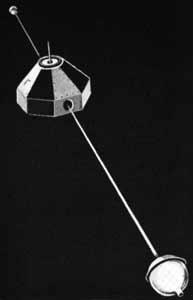Gravity Gradient Technology Satellite
This article may contain excessive or inappropriate references to self-published sources. (August 2024) |
 Gravity Gradient Technology Satellite (GGTS) | |
| Mission type | Gravity-gradient stabilization |
|---|---|
| Operator | United States Air Force |
| COSPAR ID | 1966-053A |
| SATCAT no. | 2207[1] |
| Spacecraft properties | |
| Launch mass | 47 kilograms (104 lb) |
| Start of mission | |
| Launch date | June 16, 1966 14:00:01 UTC |
| Rocket | Titan IIIC |
| Launch site | Cape Canaveral LC41 |
| Orbital parameters | |
| Reference system | Geocentric |
| Regime | Geosynchronous |
| Perigee altitude | 33,663 kilometers (20,917 mi) |
| Apogee altitude | 33,858 kilometers (21,038 mi) |
| Inclination | 4.2° |
| Period | 1,334.00 minutes[2] |
The Gravity Gradient Test Satellite was launched by the US Air Force from Cape Canaveral LC41 aboard a Titan IIIC rocket on June 16, 1966, at 14:00:01 UTC.[3] The satellite was launched along with seven IDCSP satellites, with which it shared a bus.[4] In contrast to the solar-powered IDCSP satellites, GGTS was battery powered.[4]
GGTS utilized the 26.4-pound (12.0 kg) Magnetically Anchored Gravity Systems (MACS), which consisted of two identical subsystem packages, each containing an extensible rod unit and a magnetically anchored spherical viscous damper.[5] The rod units had an extended length of 15.8 meters (52 ft),[5] and their 5-kilogram (11 lb) damper tip weights gave the satellite a symmetric dumbbell configuration.[5] The dampers were produced by General Electric and consisted of two concentric spheres separated by a viscous damping fluid.[5] The internal sphere contained a hollow cylindrical magnet which served to "anchor' the inner sphere to the Earth's magnetic field,[5] stabilizing the satellite over time.[4]
It had been hoped that within 60 days of launch, the satellite would reach a stabilization of ±8° on the x- and y-axis.[4] The results were compromised, as one of the dampers was magnetically contaminated.[4]
A follow-up GGTS mission was lost due to a launch vehicle failure on August 28, 1966.[4]
See also
[edit]References
[edit]- ^ "GGTS 1". NASA Space Science Data Coordinated Archive. Retrieved November 21, 2019.
- ^ "GGTS". Astronautix. Archived from the original on December 28, 2016. Retrieved November 22, 2019.
- ^ McDowell, Jonathan. "Launch Log". Jonathon's Space Report. Retrieved December 30, 2018.
- ^ a b c d e f "GGTS 1,2". Gunter's Space Report. Retrieved 22 Nov 2019.
- ^ a b c d e Weygandt, P.; Moyer, R. (August 1966). Attitude Control for the Gravity Gradient Test Satellite. Guidance and Control Conference. doi:10.2514/6.1966-1821 – via American Institute of Aeronautics and Astronautics.


 French
French Deutsch
Deutsch